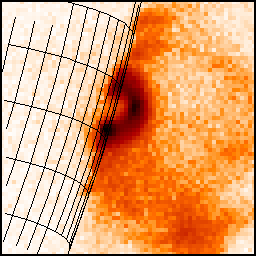
Footpoints (and ankles?)
"Footpoint" is current solar jargon, meaning generally the intersection of a coronal magnetic field line with the lower solar atmosphere (the photosphere). For background one should note several things. First, we can actually see the coronal field, albeit indirectly, in places where hot gas illuminates it (e.g., via Yohkoh soft X-ray observations - see virtually any previous Yohkoh science nugget for an illustration. Second, most of the coronal magnetic field remains firmly attached to the photosphere at both ends; otherwise there is only a single footpoint (and it most probably occurs within a coronal hole). Finally, the reader should be aware that the solar magnetic field in general (maybe especially the coronal field) continues to amaze solar physicists by its ill-understood behavior.
These properties of footpoints make them extremely interesting during flares, CMEs, or other coronal restructurings. In essence the footpoints map into the most interesting parts of the solar corona, since these regions are likely to release energy that creates the most visible effects of the flare or other restructuring.
This science nugget originated at a meeting held this week at the Nobeyama Solar Radio Observatory, in Japan, which was two-thirds devoted to the final Yohkoh archiving and documentation, a project we have named after the far-sighted Galileo. As a part of this meeting a brief science symposium took place, and by coincidence several of the papers presented there dealt with footpoints - a currently active research topic involving data from several sources, including of course Yohkoh.
As a taste of the power of footpoints, regard the following images (as already presented in an earlier nugget) from a flare of August 25, 2001:
The novel discovery reported at this week's meeting is that there appears to be a systematic separation between footpoints seen at 34 GHz (radio waves of 8.8 millimeter wavelength) and hard X-rays. The mm-waves and the hard X-rays both come from semi-relativistic or relativistic electrons, so... why is there a displacement? Its sense, for the limb flare illustrated below, is that the 34 GHz emission comes from higher up than the hard X-rays do.
By "ankles" we mean the upward extensions of the hard X-ray footpoints as implied by the 34 GHz sources. Why are they displaced? This is a newly recognized phenomenon, so we have to look at our menu of theoretical ideas and see if any of them will serve. Generally we could think about source structure, which might be subtly different even if the basic cause (electrons) is very similar; or propagation, since the radio waves in particular might be perturbed en route to the eye of the beholder (NoRH). The possible explanations would include...
Here's another unexplained discovery, although some possible theories exist. My preference would be for the last of the list above, but again a full understanding would require much more detailed information than we actually posess - how strong is the coronal field, anyway? And does it diverge enough to provide mirroring? The 34 GHz source brightness and location would be extremely sensitive to the answers to these questions. We already have at least two examples of this behavior - the Yohkoh event of November 7, 1998, and this recent RHESSI event. This is important enough for somebody to do a real study, and we hope that it happens soon.
July 13, 2002
Hugh Hudson (hudson@lmsal.com) with thanks to members of the Galileo mini-symposium at Nobeyama - Takeo Kosugi, Jun Sato, Kiyoto Shibasaki, Masumi Shimojo, et al.